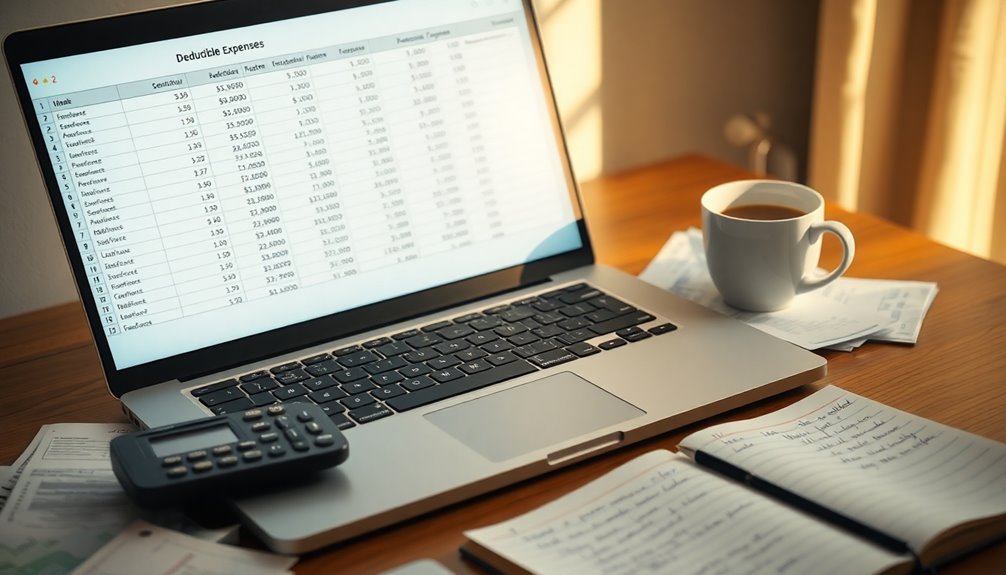To file your Uber taxes, first gather your 1099-K and any other income documents by January 31. Calculate your gross income, including fares and tips. You'll need to complete Schedule C to report income and expenses. Don't forget to deduct eligible expenses like mileage or phone costs. Make sure to submit your tax return by April 15 and pay any estimated quarterly taxes if your annual liability exceeds $1,000. Finally, keeping organized records will help minimize audit risks. There's plenty more to explore about maximizing deductions and choosing tax preparation tools that can simplify the process.
Key Takeaways
- Gather all necessary documents, including your 1099-K and tax summary, by January 31 to prepare for filing.
- Calculate your gross income and record business expenses using Schedule C to report profit or loss.
- Choose between the standard mileage rate or actual expenses for deductions, and keep organized records to substantiate claims.
- Make quarterly estimated tax payments using Form 1040-ES if your annual tax liability exceeds $1,000.
- Utilize tax preparation tools like TurboTax or specialized apps to track expenses and streamline the filing process.
Understanding Your Tax Obligations

When you drive for Uber, it's essential to understand your tax obligations to avoid any surprises come tax season. Your income includes your base fare, surge promotions, and tips, all of which are taxable. Federal tax rates range from 10% to 37%, while state tax rates vary from 0% to 10.75%, depending on where you live.
The tax brackets are based on your annual earnings, so it's crucial to keep track of how much you make throughout the year. As an Uber driver, you're considered self-employed. This means you'll pay self-employment tax, which covers Medicare and Social Security taxes at a combined rate of 15.3%. Independent contractors must manage their own tax payments, as no tax withholding is done by Uber.
You'll need to calculate this tax based on your net earnings, and if you expect your annual tax liability to exceed $1,000, you'll have to make quarterly estimated tax payments.
Required Tax Forms

Filing your taxes as an Uber driver requires specific forms to accurately report your income and expenses.
You'll receive a 1099-K if your earnings exceed $5,000, which may soon change to $600. This form summarizes your gross earnings from driving. Additionally, expect a 1099-NEC for your driving services, which replaced part of the 1099-MISC starting in 2020. If you've earned bonuses or referral fees, those will be reported on a 1099-MISC.
For reporting your income and expenses, you'll need to fill out Schedule C (Form 1040) to detail your business income and expenses. Accurate reporting of income is essential for tax compliance. Use Schedule SE (Form 1040) to calculate your self-employment taxes, and submit Form 1040 for your individual federal tax return. If you anticipate owing more than $1,000, consider filing Form 1040-ES for quarterly estimated tax payments.
Maintain thorough records with a mileage log, expense logs, receipts, bank statements, and other documents.
This documentation is critical for justifying your business expenses and ensuring compliance with IRS regulations.
The Filing Process

Navigating the filing process as an Uber driver can seem daunting, but breaking it down into manageable steps makes it straightforward.
First, gather your necessary documents. By January 31, check the "Tax Information" tab on your driver portal for your tax summary, 1099-K, and other expense details. The tax summary outlines your gross earnings and deductions, while the 1099-K shows your gross income from Uber.
Next, calculate your gross income. Use the amounts from your 1099-K and any other income sources. Record your business expenses in Part II of Schedule C, including vehicle expenses in Part IV and miscellaneous expenses in Part V. All income, including tips and bonuses, must be reported regardless of thresholds.
Once you have your numbers, fill out Schedule C to report your profit or loss. Transfer this to Line 3 of Schedule 1 and complete Schedule SE to calculate your self-employment tax.
Finally, submit your tax returns by April 15, or make quarterly estimated payments if your annual tax liability exceeds $1,000. Keep copies of all forms and receipts for at least three years in case of an audit.
With these steps, you'll be on your way to fulfilling your tax obligations!
Deductible Business Expenses

Understanding your deductible business expenses is key to maximizing your tax savings as an Uber driver. You can choose between the standard mileage rate or the actual expense method for vehicle costs. In 2024, you can deduct $0.67 per eligible business mile driven, or $0.70 in 2025.
If you opt for the actual expense method, don't forget to include gas, maintenance, repairs, and depreciation.
You can also deduct the business portion of your mobile phone and wireless plan expenses, including necessary accessories. If you use the internet to navigate the Uber app, that cost is deductible too.
Don't overlook Uber platform fees, as these are also deductible. For vehicle supplies, items like emergency kits and cleaning supplies are essential for maintaining a good passenger experience, so keep those in mind.
You can deduct up to 50% of the cost of food and drinks provided to riders, as well as any tolls, airport fees, and parking fees incurred during rides.
Lastly, professional fees for accountants or lawyers can significantly reduce your taxable income, so track those expenses carefully. Additionally, remember that maintaining organized records is crucial for substantiating claims and minimizing audit risks.
Record Keeping Essentials

Keeping accurate records is crucial for Uber drivers to ensure you maximize your deductions and stay compliant with tax regulations. Start by tracking all your earnings, including tips and bonuses, for each pay period. Use the Uber tax summary to get a clear picture of your gross and net earnings, and keep copies of your bank statements to verify income and expenses.
For expenses, document all business-related costs like fuel and maintenance, and categorize them into sections such as vehicle expenses and operational costs. Use receipt management services like Shoeboxed to scan and organize your receipts digitally, and make it a habit to log expenses regularly to avoid missing any deductible costs. Additionally, having a good system for expense documentation will help ensure you don't overlook any potential deductions.
Don't forget about mileage! Log every mile driven for business, noting the date, time, starting and ending locations, and purpose of each trip. Maintain meticulous mileage records to claim either the standard mileage deduction or actual expenses.
Lastly, keep your business and personal expenses separate, consider using accounting software for tracking, and store all records securely in the cloud for easy access and compliance. Remember to retain your tax records for at least six years.
Quarterly Tax Payments

If you drive for Uber, you'll need to get a handle on your quarterly tax payments to avoid surprises come tax season.
You're required to make these payments if your annual tax liability is at least $1,000. If you didn't owe taxes last year and filed a return for a standard 12-month tax year, you might be exempt.
Use Form 1040-ES to calculate your estimated payments based on your expected annual tax liability. It's also important to keep track of your vehicle-related expenses as they can significantly reduce your taxable income.
Make sure your payments equal 90% of the current year's tax or 100% of the previous year's tax to steer clear of penalties. There are several options for making payments: online through your IRS account, by phone, or via mail.
Be aware of the deadlines: April 15 for the first quarter, June 15 for the second, September 15 for the third, and January 15 for the fourth quarter of the following year.
Timely and accurate payments not only help you avoid penalties but also keep your records clean for future audits.
Don't forget to check on state and local tax requirements as well!
Annual Filing Requirements

What do you need to know about filing your annual taxes as an Uber driver? First, you'll need to complete Form 1040, which is your individual federal tax return.
As an Uber driver, you'll also fill out Schedule C to report your business income and expenses, and Schedule SE to calculate your self-employment taxes for Social Security and Medicare.
Keep an eye out for the 1099-K form from Uber if your earnings exceed $5,000, as it shows your gross income from rides. You may also receive a 1099-NEC for other income, like bonuses or referral fees, if they surpass $600.
Remember, you must report all your gross earnings, including tips and referral fees. This is crucial since drivers are classified as independent contractors, meaning all earnings must be reported regardless of driving frequency.
Accurate recordkeeping is crucial. Maintain logs of your business mileage and keep receipts for all expenses, like tolls and platform fees.
Gather all necessary documents before filing, including your tax summary from Uber. Add up your earnings from the 1099 forms, complete your schedules, and ensure you transfer the right information to Form 1040.
Finally, double-check everything before submitting your return to the IRS.
Choosing Expense Methods

When it comes to maximizing your deductions as an Uber driver, choosing the right expense method can significantly impact your tax outcome. You have two primary options: the standard mileage rate or actual vehicle expenses.
The standard mileage rate for 2024 is 67 cents per mile. It simplifies your calculations since you only need to multiply your total business miles by this rate. Remember, business miles include those driven while waiting for a trip, en-route to a rider, and during the trip itself. However, you can't deduct additional expenses like gasoline or insurance if you choose this method. Rideshare companies must provide 1099-K by January 31 each year, which will be important for your tax filing.
On the other hand, actual vehicle expenses require detailed record-keeping. You'll log all business and total miles driven, allowing you to deduct costs like gasoline, insurance, repairs, and depreciation. This method can be beneficial if your vehicle expenses are high.
To choose wisely, calculate your business use percentage and consider which method gives you the largest deduction.
Both methods have specific reporting requirements, so make sure you're familiar with how to report them correctly on your Schedule C.
Utilizing Tax Preparation Tools

Using tax preparation tools can make the process of filing your Uber taxes much easier and more efficient. TurboTax offers a 'Self Employment' program specifically for Uber and Lyft drivers, featuring helpful tools like the Tax Bracket Calculator and Self Employed Expense Estimator.
Plus, it allows you to import mileage and expenses directly from QuickBooks Self-Employed. By partnering with TurboTax, Uber provides discounts on their Self-Employed products, ensuring you get the best deal.
If you're looking for alternatives, FreeTaxUSA offers free advanced tax filing services for contractors, including rideshare drivers. It can import data from prior returns and checks for over 350 tax credits and deductions. Additionally, understanding self-employment tax requirements is crucial for accurately reporting your income.
Specialized apps like Stride Tax and Everlance can automate your expense tracking and cater to rideshare-specific needs.
To maximize efficiency, compare features, pricing, and user reviews among these options. With these tools, you can simplify income and expense reporting, reducing the stress of tax season.
Ultimately, utilizing the right tax preparation software can streamline your process and help ensure you're taking advantage of every deduction available.
Tips for Accurate Reporting

Accurate reporting is key to ensuring you don't face unexpected tax liabilities or missed deductions. Start by gathering all necessary documents, including your 1099-K and 1099-NEC forms from Uber, which you should receive by January 31.
Don't forget to obtain a tax summary from the Uber driver portal, detailing your income and expenses. Make sure all documents match what Uber provides.
Track and record your expenses meticulously. Maintain a daily mileage log, noting the date, time, distance, and purpose of each trip. A mileage tracking app can simplify this process. Additionally, remember that maintaining a mileage log is essential for substantiating deductions related to your vehicle use.
Keep all receipts and invoices for business expenses like vehicle costs and phone bills, documenting the purpose and amount.
When calculating your income, use the figures from your 1099 forms and list eligible expenses on Schedule C (Form 1040) to determine your profit or loss.
Choose either the standard mileage rate or the actual expense method for your vehicle expenses.
Finally, ensure you file your tax forms accurately and on time, including making any necessary quarterly estimated tax payments. Keeping thorough records will safeguard you against potential issues down the road.
Frequently Asked Questions
What Happens if I Don't File My Uber Taxes on Time?
If you don't file your taxes on time, you'll face penalties and interest that can add up quickly.
There's a 5% monthly penalty on unpaid taxes, maxing at 25%. After 60 days, the penalty could reach $485 or 100% of the taxes owed.
Plus, you'll incur interest on the unpaid amount, which compounds daily.
Staying on top of your taxes helps you avoid these costly consequences and stress down the line.
Can I Claim My Uber Vehicle as a Business Asset?
Yes, you can claim your Uber vehicle as a business asset.
It's vital to determine the business portion of its use. You may choose between the standard mileage rate deduction or the actual expense method, depending on which benefits you more.
Keep accurate records of mileage and expenses to support your claim.
Are There Penalties for Underestimating Quarterly Tax Payments?
Yes, there are penalties for underestimating quarterly tax payments. If you don't pay enough throughout the year, you could face an underpayment penalty when you file your return.
To avoid this, make sure you pay at least 90% of your current tax liability or 100% of last year's (110% if you're a high-income earner).
Keeping accurate records and making timely estimated payments can help you steer clear of these penalties.
How Do I Report Tips Received From Passengers?
You report tips received from passengers by including them in your total income on Schedule C.
Make sure to account for all tips, whether cash or through the app, as they're taxable income.
The 1099-K form will summarize your earnings, including tips, so use it for accurate reporting.
Keep detailed records of all tips and related expenses to ensure you're compliant with IRS regulations.
It's crucial to report everything correctly to avoid issues later.
Can I Deduct Expenses for a Vehicle Not Registered in My Name?
Yes, you can deduct expenses for a vehicle not registered in your name, as long as you use it for business purposes.
You'll need to keep detailed records showing how you use the vehicle, including mileage logs and receipts for expenses.
Always document the business versus personal use to calculate the deductible portion accurately.
Just remember to maintain this documentation for at least three years in case of an audit.
Conclusion
In summary, filing your Uber taxes doesn't have to be overwhelming. By understanding your tax obligations, keeping accurate records, and tracking deductible expenses, you'll streamline the process. Remember to choose the right expense methods and utilize tax preparation tools to make filing easier. Staying organized throughout the year will help you avoid last-minute stress. With these tips in mind, you're ready to tackle your Uber taxes confidently and accurately.









